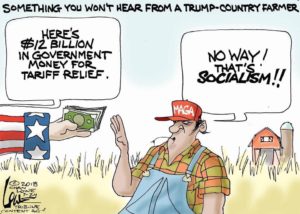Bloomberg News recently reported Trump’s $28 Billion Trade War Bailout Is Overpaying Farmers:
President Donald Trump’s $28 billion farm bailout may be paying many growers more than the trade war with China has cost them.
The U.S. Department of Agriculture’s calculations overshot the impact of the trade conflict on American soybean prices, according to six academic studies, a conclusion that is likely to add to criticism that the bailout has generated distortions and inequalities in the farm economy.
“It’s clear that the payment rates overstated the damage suffered by soybean growers,” said Joseph Glauber, the USDA’s former chief economist who published a review of the research in late November. “Based on what the studies show, the damages were about half that.”
* * *
[A] team led by Zheng estimated the trade conflict depressed U.S. soybean prices by only 36 cents per bushel in its first year, a period in which the bailout program paid soybean growers more than four times that: $1.65 per bushel.
And to be clear, these overpayments are not going to the average family farmer, but overwhelmingly to large corporate agribusiness. Bloomberg News also reported, Trump Pledged to Help Small Farms. Aid Is Going to Big Ones:
Donald Trump promised he would help embattled small farmers caught in the crossfire of his trade war with China. But big farms so far have been the main beneficiaries of the billions of dollars being distributed in aid payments.
Half of the Trump administration’s latest trade-war bailout for farmers went to just a 10th of recipients in the program, according to an analysis of payments by an environmental organization. The study asserted that payouts have been skewed toward larger operations and wealthier producers.
 The top 1% of beneficiaries from the trade aid received 13% of the money distributed in the first round of payments under this year’s Market Facilitation Program, with an average payment of more than $177,000. But the bottom 80% of recipients received an average payment of $5,136, according to the Environmental Working Group, which analyzed records obtained through the Freedom of Information Act.
The top 1% of beneficiaries from the trade aid received 13% of the money distributed in the first round of payments under this year’s Market Facilitation Program, with an average payment of more than $177,000. But the bottom 80% of recipients received an average payment of $5,136, according to the Environmental Working Group, which analyzed records obtained through the Freedom of Information Act.
The analysis echoes the findings of an assessment of last year’s trade aid program that also found benefits were tilted toward large farms. That’s likely to stoke criticism of the cost of the $28 billion bailout and accusations of inequities.
Senate Democrats earlier this month issued a report arguing Trump’s trade aid favors Southern farmers at the expense of their counterparts in the Midwest and Northern Plains, growers of cotton over soybeans, and large producers over smaller ones.
* * *
U.S. farmers have become increasingly dependent on federal aid [welfare]. The farm rescue is now more than twice as expensive as the 2009 auto industry bailout, which ultimately cost taxpayers $12 billion. Almost 40% of projected U.S. farm profits this year will come from trade aid, disaster assistance, federal subsidies and insurance payments, according to the American Farm Bureau Federation.
Farmers and rural residents are a critical Trump constituency, and he is using taxpayer money to buy their votes (quid pro quo bribery) with socialized farm welfare bailouts.
As for the working poor who need food assistance throughout the year, at this Christmas season the Trump administration is defying the will of Congress by implementing cuts to the Supplemental Nutrition Assistance Program, better known as SNAP (formerly administered via food stamps), which provides aid to over 36 million people. Trump administration moves to remove 700,000 people from food stamps:
The Trump administration said on Wednesday it will make it harder for states to keep residents in the U.S. food stamp program in a move that is projected to end benefits for nearly 700,000 people.
President Donald Trump has argued that many Americans receiving food stamps through the Supplemental Nutrition Assistance Program, known as SNAP, do not need it given the strong economy and low unemployment. The program provides free food to 36 million Americans.
The administration has now finalized a rule that tightens guidelines on when and where states can waive limits on how long certain residents can receive benefits. The changes will move more “able-bodied” adults into the workplace, U.S. Agriculture Secretary Sonny Perdue said.
“States are seeking waivers for wide swaths of their population, and millions of people who could work are continuing to receive SNAP benefits,” he told reporters.
The United States generally limits the amount of time that adults ages 18-49, who do not have dependents or a disability, can receive food stamps to three months in a 36-month period, unless they meet certain work requirements.
States can apply for waivers to this time limit due to tough economic conditions.
The agency is stiffening guidelines defining where recipients can reside to be eligible for waivers and standards for demonstrating whether an area has enough jobs to justify a waiver.
Importantly, the Trump administration is circumventing Congress. Congress has repeatedly rejected changing the time-limit rules:
The administration has sought to tighten requirements for food stamps without congressional approval after Congress blocked a Trump-backed effort to pass new restrictions through the Farm Bill last year.
The latest rule will take effect next year and save the U.S. government $5.5 billion over five years by removing about 688,000 people from food stamps, said Brandon Lipps, a USDA deputy undersecretary.
Well, I can save the government $28 billion by ending the trade war farm bailout, which in reality is Trump using taxpayer money to buy farm votes (quid pro quo bribery) with socialized farm welfare bailouts, most of which is going to large corporate agribusiness.
Republicans are the party of an unrepentant Ebenezer Scrooge — everything for the rich, nothing for the working poor.
I’m mixing metaphors here, but Rep. Marcia Fudge in an op-ed at the Washington Post writes, The Trump administration plays the perfect Grinch with its new food stamp rule:
There is a horrible irony in taking food from the tables of hungry Americans during the holidays, but that’s the latest act of cartoonish villainy by the Trump administration.
It could be, perhaps, that their shoes were too tight or that their heads weren’t screwed on just right, but this week, the Agriculture Department played the part of the Grinch, finalizing a rule to cut billions of dollars from the Supplemental Nutrition Assistance Program (SNAP), formerly known as food stamps. The rule will remove nearly 700,000 from the program and jeopardize the food security of hundreds of thousands more, representing a callous escalation of the Trump administration’s war on people in need.
In my work representing Ohio’s 11th Congressional District, where too many hard-working people need a little extra help putting food on the table, I have learned some things to be true about hunger and anti-hunger programs such as SNAP.
The truth is SNAP works. It lifts millions out of poverty in this country and helps millions more make ends meet. The White House, the USDA and congressional Republicans would have us believe this rule simply helps poor people escape the cycle of poverty. SNAP already does that.
The truth is SNAP is temporary. While conservatives continue to blow the abhorrent Reagan-era dog whistle of “the welfare queen,” the majority of SNAP recipients draw benefits for less than a year.
 Maybe we need a caricature of the “corporate agribusiness welfare king.” Oh wait, they really do exist! Trump administration showers Brazilian crooks with $62M bailout money meant for struggling U.S. farmers: The Trump administration has forked over more than $62 million — taxpayer cash that was supposed to be earmarked for struggling American farmers — to a massive meatpacking company owned by a couple of corrupt Brazilian brothers, Joesley and Wesley Batista.
Maybe we need a caricature of the “corporate agribusiness welfare king.” Oh wait, they really do exist! Trump administration showers Brazilian crooks with $62M bailout money meant for struggling U.S. farmers: The Trump administration has forked over more than $62 million — taxpayer cash that was supposed to be earmarked for struggling American farmers — to a massive meatpacking company owned by a couple of corrupt Brazilian brothers, Joesley and Wesley Batista.
The truth is the vast majority folks on SNAP who can work do work. Able-bodied adults who are capable of working but don’t can only draw SNAP benefits for three months within any three-year period.
The truth is both red and blue states want the flexibility this rule will eliminate. The rule will dramatically reduce the flexibility of states to decide how best to serve the needs of their own citizens. That flexibility has been requested and granted by both Republicans and Democrats alike. For all their talk about states’ rights, conservatives in Congress and the administration are all too happy to curtail those rights in the name of political messaging.
The truth is the USDA has no idea if this rule will even accomplish what it sets out to do. While the USDA has the authority to research whether those affected by this rule are disabled or elderly or veterans or any number of other classifications that may exacerbate their need, the department has chosen not to. If it had, the USDA would discover many SNAP recipients are either attempting to find work or face hardships that prevent them from doing so. Instead, it demonized them as lazy and undeserving.
The truth is the USDA is an agriculture and food agency, not a workforce agency. While Republicans talk a great deal about putting people back to work, the USDA lacks the expertise and the resources to adequately administer the workforce education and training programs Republicans claim to want. Instead, the rule focuses only on the conservative deliverable of cutting people off SNAP, and doesn’t make any good-faith effort to address the issue of putting people back to work.
The truth is this rule is only a single campaign in the White House’s larger war on people in need. Over the past year, the Trump administration has advanced no fewer than 14 rules attacking access for underserved populations to everything from housing to health care to food.
I’d like to think, like the Grinch, this administration will be moved during this holiday season to see the good in helping the poorest and most vulnerable among us. The truth, I fear, is much worse. The president has cynically weaponized the USDA as a blunt political instrument, flying in the face of the department’s stated mission to “do right and feed everyone.” It is a new low in the administration’s war on people in need.
As Adam Serwer observed, The Cruelty Is the Point: “It is not just that the perpetrators of this cruelty enjoy it; it is that they enjoy it with one another. Their shared laughter at the suffering of others is an adhesive that binds them to one another, and to Trump.”
UPDATE: Steve Benen adds After cutting taxes for the wealthy, Team Trump targets food stamps (excerpt):
An analysis from the Center on Budget and Policy Priorities fleshed out [this regulation] further, noting that the “draconian rule” adversely affects “the poorest of the poor”: Americans whose average income “is just 18 percent of the poverty line.” Currently, their average monthly SNAP benefits total about $165 per month.
And now, the Center on Budget and Policy Priorities analysis added, the Republican administration is ending “basic food assistance for nearly 700,000 of the nation’s poorest and most destitute people.”
In case this weren’t Dickensian enough, let’s also note for context that the news is reaching the public just a few weeks before Christmas.
What’s more, as New York’s Sarah Jones explained, this isn’t the only element of the Trump administration’s plans to restrict low-income Americans’ access to food assistance:
Another proposal, which the USDA is likely to finalize, would take food stamps from another 3 million people. Right now, households with incomes up to 200 percent of the federal poverty level can receive food stamps. The New York Times explained, for reference, that this guideline extends food aid to families of four with a household income of about $50,000. Households with assets of at least $2,250 would also no longer be eligible for aid.
 The USDA itself has admitted that its reforms would cost almost half a million children their free school lunches, since eligibility is often determined by a household’s receipt of food stamps. The Urban Institute has estimated that the administration’s three rule changes, if finalized, will deprive around 3.7 million people total of food aid.
The USDA itself has admitted that its reforms would cost almost half a million children their free school lunches, since eligibility is often determined by a household’s receipt of food stamps. The Urban Institute has estimated that the administration’s three rule changes, if finalized, will deprive around 3.7 million people total of food aid.
[Trump] seems convinced that low-income families lack any kind of political capital – in addition to lacking actual capital – which leads Trump administration officials to target them with new punishments, even as the wealthy and big corporations enjoy their generous GOP tax breaks.
Discover more from Blog for Arizona
Subscribe to get the latest posts sent to your email.

This POTUS must be the most stupid one in our history. He doesn’t read and doesn’t even understand that military families also receive food stamps. That’s right, military families. Under federal guidelines,lower rank enlistees who have spouses and children do not earn enough to support their families. That is why they are eligible. We have got to fight corporate welfare which puts big businesses ahead of the poor. Enough of the republican discrimination against the poor in favor of the most wealthy.
According to a 2016 report from the Government Accountability Office, more than 23,000 active-duty troops used the food stamp program in 2013, the last year for which such information was available. “Why Do Military Members Qualify for Food Stamps?”, https://www.military.com/paycheck-chronicles/2018/02/21/why-do-military-members-qualify-food-stamps.html “The data on how many troops use SNAP are notoriously difficult to track, in part because the U.S. Department of Agriculture, which manages SNAP, does not share the data with the Defense Department.”
Almost 1.4 million veterans live in households that participate in SNAP (formerly food stamps), CBPP analysis of data from the Census Bureau’s American Community Survey finds. “SNAP Helps Almost 1.4 Million Low-Income Veterans, Including Thousands in Every State”, https://www.cbpp.org/research/food-assistance/snap-helps-almost-14-million-low-income-veterans-including-thousands-in “The 1.4 million figure, an annual average for the 2015-2017 period, represents veterans who received SNAP at any point during the previous year. For low-income veterans, who may be unemployed, working in low-wage jobs, or have disabilities, SNAP provides an essential support that enables them to purchase nutritious food for their families. “